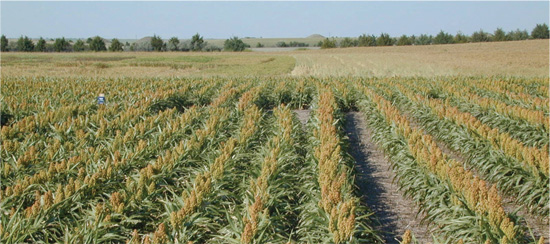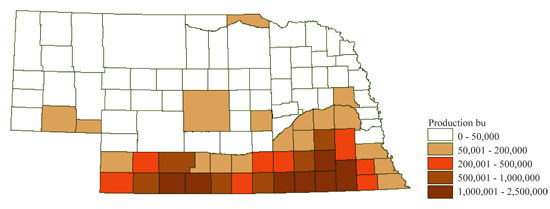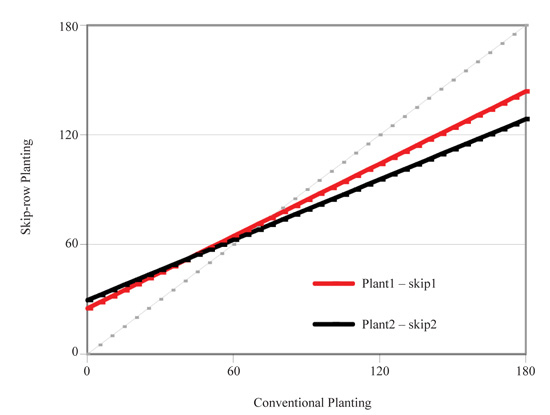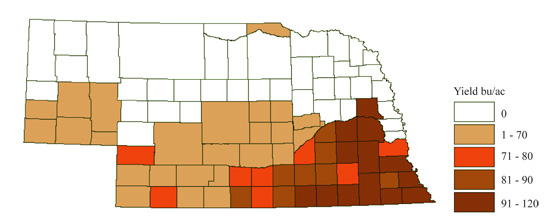G1976
Skip-Row Planting of Grain Sorghum for Improved Drought Tolerance
This NebGuide advises on skip-row planting as a means to improve grain sorghum production under water-deficit conditions.
Charles S. Wortmann and Richard B. Ferguson, Extension Soils Specialists
Robert N. Klein, Extension Cropping System Specialist
Drew J. Lyon, Extension Dryland Cropping Specialist
Steve R. Melvin, Extension Educator
- Research Findings
- Targeting of Skip-row Planting of Grain Sorghum
- Conditions Favoring Skip-row Planting Success
Skip-row planting involves leaving some rows unplanted to save stored soil water under the unplanted row areas for use during reproductive stages of growth (Figure 1). Roots do not reach this water until well into July. Common skip-row configurations are planting alternate rows (plant – skip1) or alternate pairs of rows (plant2 – skip2), or planting two rows and skipping one row (plant2 – skip1).
 |
| Figure 1. Conventional planting on the left, compared with plant1 – skip1 on the right. Panicle development is more advanced with the skip-row planting because of better soil water availability. |
Grain sorghum is known for its drought tolerance, and is grown primarily in the southern counties of Nebraska (Figure 2). In southeastern Nebraska, grain sorghum typically is produced on the relatively more drought-prone land. Research results from Nebraska and Kansas indicate that grain sorghum has a yield advantage relative to corn for average yields less than 100 bu/ac when the main constraint is inadequate water. Because grain sorghum has lower production costs than corn, due to lower seed costs and generally lower nitrogen needs, it may be more profitable than corn if average yields are less than 120 to 140 bu/ac, depending on land values. In the Nebraska Panhandle, the combination of less rainfall and a short growing season limits grain sorghum production at elevations above 4,000 feet.
 |
| Figure 2. Average bushels of grain sorghum production in Nebraska by county based on NASS data for 2004 to 2007. |
Research Findings
Research involving skip-row sorghum was evaluated in 12 experiments in Nebraska, from 2005-2008. In 10 trials conducted from Clay Center to Sidney, plant1 – skip1 grain yield (YP1:S1) was related to all rows planted (YS0) as YP1:S1 = 25 + 0.66 YS0.
Skip-row planting of grain sorghum resulted in higher grain yield when grain yield was constrained by inadequate rainfall to 70 bu/ac or less; at higher yields, skip-row planting did not have a yield advantage.
In fact, at higher yield levels, skip-row planting reduced yield relative to planting every row (Figure 3). The average yield for 23 counties was less than 70 bu/yr during 2004-2007 (Figure 4). Grain yield stability was improved with skip-row planting with less risk of crop failure, an important consideration if the crop is not otherwise insured.
 |
| Figure 3. Grain sorghum yield (bu/acre) with skip-row compared with conventional planting. |
 |
| Figure 4. Average grain sorghum yields (bu/ac) in Nebraska by county based on NASS data for 2004 to 2007. |
Plant2 – skip1 planting was evaluated in 2005 and 2008 at Curtis, but not in the other 10 trials. The 2005 results indicate that plant2 – skip1 planting results in higher yields, compared with all rows planted, where average yields are less than 80 bu/ac.
In 2008, the average grain sorghum yield was 121 bu/ac with all rows planted and 108 bu/ac with plant2 – skip1. Approximately 38 percent of Nebraska grain sorghum production has average yields of less than 80 bu/ac (Figure 4).
Sorghum panicle emergence and pollination are often delayed with soil water deficits. This was observed at three sites in 2005 where pollination was 10 to 12 days later with all rows planted, compared with skip-row planting (Figure 1). Such delays increase the risk of killing frost before the grain is mature. Skip-row planting may result in fewer tillers and more uniform panicle maturity.
Targeting of Skip-row Planting of Grain Sorghum
Skip-row planting is likely to result in increased grain sorghum yield where yields are less than 70 to 80 bu/acre (Figure 4). There is much variation in average yields within counties, however, so consider the field’s yield history, as well as soil water content, at planting.
A yield advantage can be expected with plant1 – skip1 and plant2 – skip2 where yields are less than 70 bu/acre and with plant2 – skip1 where yields are less than 80 bu/acre. Yield with plant2 – skip2 is similar to plant1 – skip1 with slightly less yield potential when rainfall is adequate and both are likely to yield more than plant2 – skip1 under severe water deficit stress.
If there is more soil water than normal at planting, the yield potential is increased and skip-row planting is less likely to be beneficial.
Conditions Favoring Skip-row Planting Success
The following conditions favor success with skip-row planting.
- No-till planting and a good residue cover. Fields with poor residue cover from tillage, grazing/haying, or a poor previous crop should be planted every row. Best results are expected if the previous crop is winter wheat. Harvesting to maximize stubble height, uniform spreading of the straw and chaff, and minimizing traffic to have more standing stubble help reduce evaporative losses. Stripper headers maintain more standing wheat straw that conserves soil water and suppresses weeds.
- Soil with good available water-holding capacity, e.g., at least 1.75 inches of water per 12 inches of soil depth. The best results are expected with deep loam, silt loam, and silty clay loam soils.
- Good weed control following the previous harvest and during the crop season to avoid depletion of soil water.
- Frequent occurrence of soil water deficits during the reproductive stages.
- Expected yield is less than 70 to 80 bu/ac, especially if soil water is less than normal at planting.
Skip-row Management
- Maintain crop residue cover and control weeds.
- Fertilize according to a realistic yield goal. Reduce the risk of nitrogen loss under semi-arid conditions with injection into the soil. Inject nitrogen fertilizer between and at least 2 inches from the planted rows; do not apply in the skip-row area to minimize residue disturbance. If nitrogen fertilizer is broadcast, apply preplant to increase probability of sufficient rainfall to move the nitrogen into the root zone; apply non-urea fertilizer to minimize volatilization loss.
- Plant at the same seed rate per acre as with planting all rows. Thus, the within row plant density will increase by 100 percent with plant1 – skip1 and plant2 – skip2, or 50 percent with plant2 – skip1.
Weed Management
- Select seed with a seed safener for the herbicides selected. Currently the most effective herbicide for weed management in grain sorghum, where labeled, is Lumax®. Less expensive options include use of Bullet® or Bicep II Magnum®. Try to apply up to 21 days before planting. This increases the probability that enough rain will fall to activate the herbicide and control weeds before the crop emerges. If weeds emerge before the crop, use a burndown herbicide. These weeds may be too large when the crop reaches the growth stage to safely treat it with most post-emergence herbicides. Several postemergence herbicides are available for broadleaf weed control in grain sorghum but very few offer grass weed control, and must be applied when the grasses are very small.
- Good crop residue is important in weed management. Weed population with 6,000 lb/acre of winter wheat straw residue (approximately the amount of residue from a 60-bushel wheat crop) can be only 20 percent of the weed density when planting into bare soil.
Disadvantages of Skip-row Planting
- More yield is expected with conventional planting than with skip-row planting in relatively wet years, such as when total growing season available water is more than 27 inches.
- Weed control is likely to be more difficult. Proper selection and use of a pre-emergence herbicide is important. Use of shields to protect sorghum plants during glyphosate application may be feasible.
- Crop insurance may not be available or only partially available.
Confirm that the Farm Service Agency recognizes a skip-row planted field as fully planted and that all acres are counted as planted acres.
This publication has been peer reviewed.
Disclaimer Reference to commercial products or trade names is made with the understanding that no discrimination is intended of those not mentioned and no endorsement by University of Nebraska–Lincoln Extension is implied for those mentioned. |
Visit the University of Nebraska–Lincoln Extension Publications Web site for more publications.
Index: Crop Production
Field Crops-Sorghum
Issued November 2009